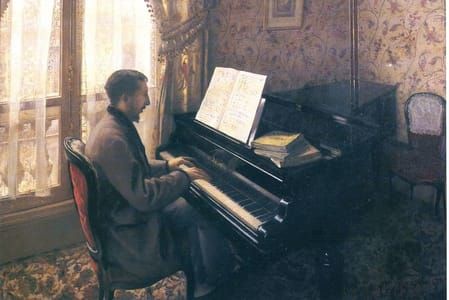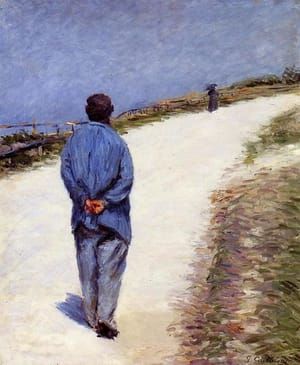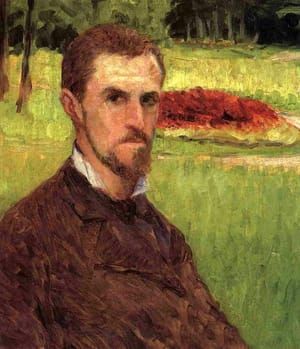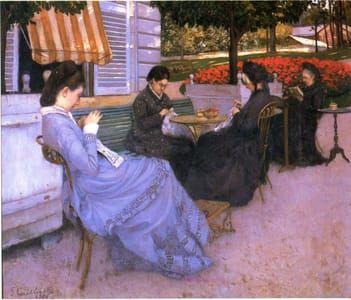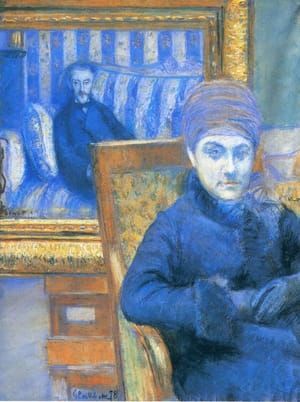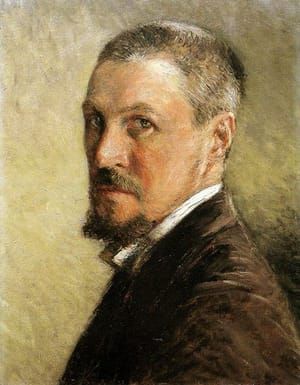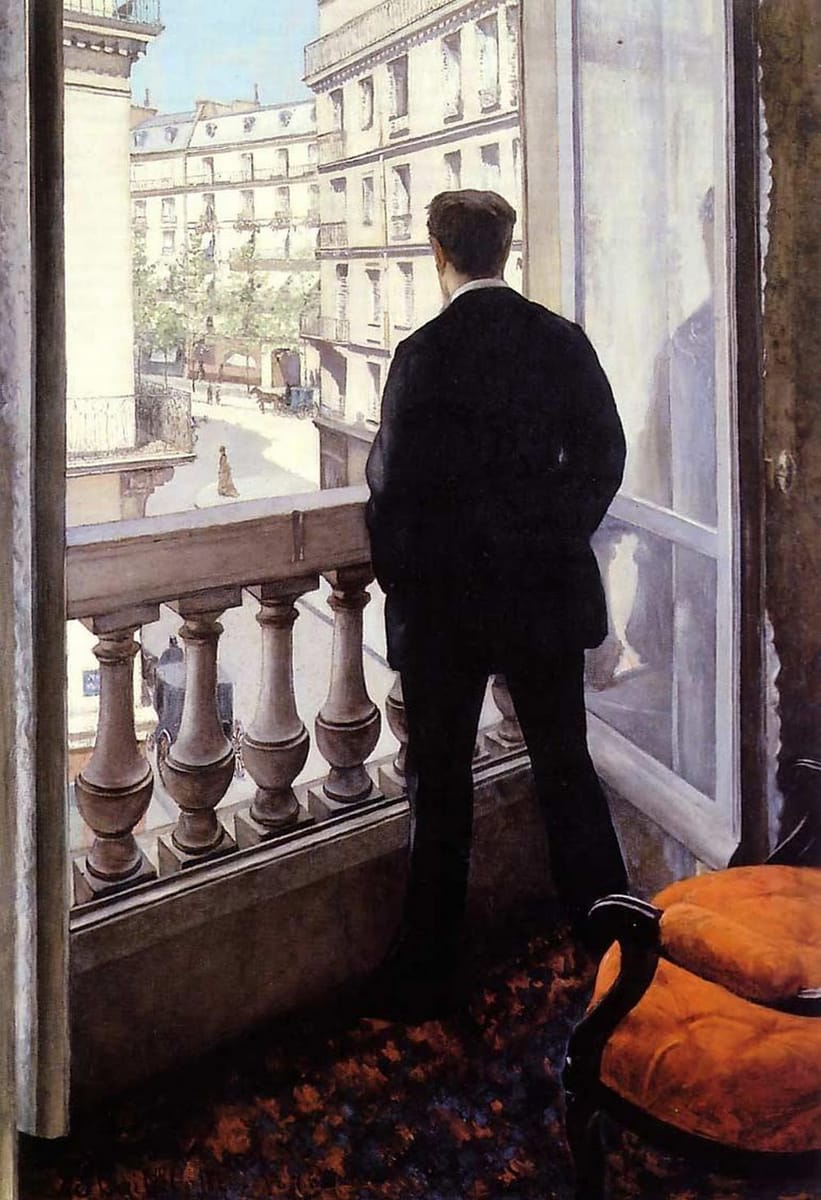

Jeune homme à la fenêtre (Young Man at His Window), 1875
Gustave Caillebotte
The artist's brother, René Caillebotte, wearing informal clothes, stands at a balcony by a window of the family home in the Rue de Miromesnil in Paris, looking outwards into Boulevard de Malesherbes (the large, oblique cross-street in the background). This comparatively early work in Caillebotte's oeuvre reveals his interest in urban Realism.
Its theme of a figure seen from behind at an open window has precedents in German Romanticism, a notable example being Caspar David Friedrich's Woman at the Window...
Caillebotte's painting differs from his German antecedents in several ways, however. The man does not gaze upon nature, but rather looks out upon an urban scene. According to the art historian Kirk Varnedoe, "a standard charm of the window view is our bemused curiosity as to what the observer is looking at; but Caillebotte's structure replaces this curiosity with something quite different." By placing the onlooking man off-center and depicting him from a somewhat elevated viewpoint, Caillebotte's painting creates a tense relationship between the dominant foreground figure, the emphatic perspectival diagonals, and the detailed street scene beyond. Varnedoe says "the normal interior-exterior oppositions of the window are thus combined in a charged relationship, competitive or covalent, that is seemingly unprecedented."
Caillebotte presented this painting at the Impressionism exhibition of 1876 alongside a few of his other works, including Les raboteurs de parquet. Writer Émile Zola was impressed with technical achievement of the works, but was not enthusiastic about the style: "Photography of reality which is not stamped with the original seal of the painter's talent—that's a pitiful thing." He called the painting "anti-artistic... because of the exactitude of the copying."
[https://en.wikipedia.org/wiki/Young_Man_at_His_Window]
The Domination of the Window in Gustave Caillebotte’s Young Man at His Window
Concern with capturing the fleeting moment within an unfolding narrative manifested the aim of the late-19th century avant-garde painters known as the Impressionists. The protagonist of their visual narratives became Paris. Several of the artists chose to paint the city from a higher perspective, as observers of the renovated city, now the European embodiment of sheer modernity, without any signs of idleness or discontent. Vantage point did not exist in the city center, but from within a restricted space where the walls converge and perspective is regulated by a window. The more conservative Impressionist, Gustave Caillebotte, embraced a similar repertoire. Man at His Window, exhibited by the more conservative Impressionist at the group’s independent exhibit on the Boulevard des Capucines in 1876 presents a unique contradiction. The painting is a visual representation of the new rigidly accurate cityscape seen from a bourgeois apartment.
Haussmann’s Paris appears cleared of any destructive revolutionaries, flawlessly organized, and untainted. Recent scholarship has read the painting as Caillebotte’s documentation of Haussmann’s new residential quarter at the corner of the rue de Miromesnil and the rue de Lisbonne, permitted by the bright, open window, with the bourgeois rightfully reassuming control of Paris from the Communards. One cannot overlook the social, political, and historical context from which the work developed however. The separation between interior and exterior space constituted by the window behind which the Parisian surveys the city provokes questioning of agency. The modern Paris provided arcades, street lights, new boulevards; a city of entertainment reserved for the bourgeois. Yet Young Man at His Window does not coincide with this thesis. It exhibits an alienating tone that leads one to question the greater significance behind Caillebotte’s employment of the window. The following research will gather that the window is a technique the artist utilizes to speak to the greater psychological affects that underlay the city’s redevelopment. Following the Second Empire and anarchic Paris Commune the individual gained speculation, but at the cost of personal agency.
Under the aegis of Napoleon III’s Prefect of the Seine, Baron Haussmann, the city transformed into the European embodiment of sheer modernity. There was a new sewage system, introduction of the first department stores, widened boulevards, and even renovated apartments to house the rising bourgeoisie. These materialistic amenities that the urban project was responsible for came at the cost of societal humility and honesty among the bourgeoisie.
Despite the brief, yet traumatic siege of the city during the Paris Commune from March 1871 to May 1871, Impressionists continued to to paint Paris as it had existed during Napoleon III’s reign, denying the tragic traces that the Commune had left. Young Man at His Window recuperates the recently fought-over Paris with the untainted, rigidly organized, and brightly lit view of the street outside. A male silhouette observes a particular part of the city from the metal of his balconied window, a part of the new world of industry and capitalism. Its striking perspective begs further analysis because the subject, who is Caillebotte’s brother, René, is a largely painted silhouette. The audience and René are both given the role as spectators, but of different scenes. The audience watches René as he stands in his cramped apartment, furnished by a red Turkish carpet and chair positioned in front of the window. This exuberantly modern city seems, on closer examination, uncomfortable; René’s over-large body seems lost in this enclosed space that is juxtaposed by the openness of the boulevard.
René’s view is controlled by the space between the window. He stands closely in front with his hands in his pockets in confidence. He pays no mind to his environment, nor to the viewer who watches him.This description of the atmosphere is concluded by Rapetti that this activity of speculation is one René practices often. The chair’s location alludes to the monotonous nature of the subject’s life. Time is wasted in wondrous speculation of events in which he has no active role. Furthermore, the chair reminds the audience of René’s limitations. Although he can physically move inside, the chair is set close to the window emphasizing his entrapment between interior and exterior, not fully present in either space. It follows that Caillebotte is not taking apart public and private space of the period, but rather reinforces them by separating man from his reclaimed city.The strict vantage point from which René looks out juxtaposes the strict paving of the boulevards. His well-to-do position that Haussmannization has endowed him with is an overlaying façade to mask the greater disillusionment the bourgeois feels. René’s mental absence from his home and preoccupation with this idly desolate part of Paris leads Jame H.Rubin to believe him to be masculinely insecure. His largely painted body does not coincide with his actions. There is a slight tension between René’s field of vision and his physically dominant body. René dominates the composition, but is dominated by the window. He has risen in melancholy temperament from his chair to possibly daydream of what could be going on around the corner. Perhaps he is having a flashback to reminisce about life before Haussmannization, when he was within closer physical proximity with his neighbors as well as more emotionally connected with other Parisians, as opposed to preoccupied with attaining even greater wealth. Instead of commanding his own space, René is mentally elsewhere, taking control of the view that his window allows him. Despite his largely painted physique, he is not attentive to his surroundings, read as vulnerable, and his position away from the viewer makes it difficult for the audience to characterized him.
Caillebotte paints his brother as a mysterious and alienated shadowed silhouette René is unaware of the viewer behind him. As a result the viewer is unable to relate with the subject. The audience’s view is less limited than René’s. The subject is solely interested in the scene that the window separates him from. It takes away his agency. Perhaps he wants to take a more active role, but this piece of furniture limits his agency and he can only remain an observer. The viewer cannot know what occupies René’s thoughts: interest, escape, perhaps hope. This makes it unlikely for the audience to identify with him. The psychological distance between the audience and René is enhanced by the alternating perspectives and intricate attention to detail in terms of illustrating the complexity of the balustrade he stands against. The realistic quality of Caillebotte’s small brushstrokes reflects its search for realism, with the bourgeois being controlled by his environment, despite his assumed superiority. Paris is not praised and Herbert says Caillebotte has taken away the “natural and the delicate,” and rather introduces the naturalism of the new city, full of tensions and harsh powers.” For the post-Commune Parisians their reclaimed city became a character for entertainment, but it seems here that Caillebotte creates an allegory out of this statement by juxtaposing René’s shadowed silhouette with the luminous scene that he scrutinizes.
The window’s location and measurements limits the individual’s experience of Paris. René’s can only see through the widely angled lens between the window’s perimeters. It does not matter if René moves forward, backward, or leans against the window. His view depends on the magnitude of the window itself. Ordinary life is seen through this window, but perhaps a more important event is occurring in a space that the window does not permit those inside to bear witness of. The view of the city for the audience is framed by René, as the observer from this encasement; a space between exterior and interior space, not truly a part of either. Although many scholars believe that René’s attention is focused on the woman below, possibly jealous of her physically freedom, art historian, Alexandra K. Wettlaufer hypothesizes that René’s thoughts are filled with disbelief of the city’s destitution despite its recent modernization. This illustration of the bourgeois male reflects the alienating distance he feels from the new Paris following the rapid demolition of the vieux Paris. A critic of the city has commented on this new activity of watching, the city, instead of being a participant of it saying, “What a cruel thing observation is, and how unfortunate is the observer.” Out of the range of elements that make up one’s experience, observation is one used by Caillebotte to emphasize it’s passive nature. The individual watches a scenario unfold; there is little to know social engagement. René is unable to relate to this new city of commodity and speculation that leads him to observe it from a distance as opposed to having a more active role.
Edmond Duranty, the 19th century writer of The New Painting, describes the window as an apparatus for communication where there is a consistent dialogue between the Parisian and his city. It is made possible by the permanent presence of windows within his own home. Because the window is an object of the environment, perpetually there, he says that one is fortunately provided with “changing impromptu views that are the greatest delights of life”. René’s communication however is unidirectional because his experience with the desolate street occurs from a peripheral position because those below are unaware of his scrutiny. The young man can, in this respect, be interpreted as assuming domination because he is allowed a view that few other’s enjoy, permitted by the window. However this control is contradicted because the window singles in on only one small part of the city. Whether one stands near or far, the window remains static, only capturing on portion of the city. The individual who watches from above is thus granted a limited portion to a greater whole, naive to the events beyond where they stand due to this encasement within which they become alienated. This is therefore a tool of manipulation that Caillebotte uses to speak to the disturbing levels of melancholic boredom and lonesomeness that underlay Paris’s beauty.
Young Man at His Window has been impeccably studied alongside its contemporary Interior, Women at the Window, which was painted four years later. Both paintings capture the city scape and post-Commune from an elevated perspective, but render diverging levels of agency in respect to the window. The painter is interested in illustrating the juxtaposition between decorative trappings and open spaces along newly paved streets, with the Parisian caught in between. Inside, the bourgeois is safe, from capitalism, but is also reminded of its power because of the furnishings that flood the private space, further drawing attention to the agency that the individual seems to be losing.While René overshadows the composition in Young Man at His Window, the subject of the latter is a tentative woman.The viewer observes the subject’s preoccupation with a scene they are separated from by a window, and observe the rigor of the enclosed space in which these largely represented bodies statically stand. In several of Caillebotte’s paintings that represent Paris from above, the pressing perspective and geometric precision contribute to the artist’s dedication to accuracy. He illuminates the streets with sunlight to highlight the benign nature that underlay the Paris. The Impressionist’s portrayal of the built environment, the newly built apartments growing skywards, and the narrow interior embody the Second Empire’s move towards modernity, but also suggests’s a dehumanizing effect. In Man at His Window, René has a privileged, more open view of the street, keeping in mind that the amount of the boulevard he can see is controlled by the window itself. Under this light, one may say that he controls his physical space inside, and mentally controls the space outside. Moreover, he is not completely a part of either sphere so, contrary to Herbert, it would be negligent to say he enjoys primary agency of either of the two atmospheres. In the latter, the woman’s vision is also limited by the framework of the window. Her loss of agency is further restricted by Haussmann’s buildings which seem to be closing in on her space from the outside, similar to the way her husband, who is seated behind her, entraps her space from the interior. renovated city below, but her thoughts are interrupted by yet more of Haussmann’s buildings.
Norbert Wolf’s references Husymans À Rebours to make the case that the woman’s existence behind the window signifies the alienation she feels from her husband who is seated directly behind her, preoccupied with reading the newspaper. As a result, the woman looks outwards to the street below that she cannot reach in order to escape the psychological distance she feels on the interior. René is free to move inside between the open spaces of his cramped apartment, but chooses not to in preference of watching that idle happenings outdoors, perhaps towards the blue sky that the buildings seem to interrupt. The woman however is not free to move inside nor outside because insider her space is interrupted by her husband and her window only allows her a view of yet another building, not a birds eye view of the street itself. The increasingly tightened limits of her views and movement allude to the hierarchical control that men still enjoyed even late in the century. Because he is a male, René dominates the public sphere by virtue, as proven by his capability to watch the woman crossing the street below without having his scrutiny reciprocated. The woman figure in Interior, Woman at the Window is denied the same agency because her physical space is made increasingly crowded by the presence of the accompanying male figure. By comparing Man at His Window with Interior, Woman at the Window Caillebotte’s agenda is crystallized. On the one hand, his artistic hand in accurately illustrating the city following Baron Haussmann’s reconstruction work to praise the preceding empire’s innovations. Under this superficiality however, Caillebotte uses the juxtaposition between interior and exterior space to speak against modern reputation Paris has. The window becomes a metaphor to showcase the realistic boredom that the Parisian experienced, both inside and out. Women, as well as men, to a lesser degree of course, watch the deserted urban space. The initial praise for the Second Empire’s achievements thereby, become increasingly doubtful.
Unlike Caillebotte who practiced a degree of naturalism in his urban paintings, one of his contemporaries, Claude Monet, preferred a more idealist approach in capturing the fleeting moment. Both artists worked within the framework of painting the city as it had existed during the Second Empire as well as after it had been cleaned of the blood and destruction the Communards had left behind, but instill differing importance in their paintings from above. Boulevard des Capucines, completed in 1873, is an appropriating contrast in terms of view of the city to Man at His Window. In Monet’s work the audience sees a crowded boulevard caught in a moment, explaining the largely loose brushstrokes. Caillebotte’s boulevard is the opposite with no eager shopping, obnoxious socializing, or fussiness. René is not part of the city scene, but his window grants him the freedom to watches a woman who is in the street without being noticed, he occupies a different role than Monet’s Parisians. The viewer is granted the ability to self-identify with the Parisian observer because of the two bourgeois men whose faces can be discerned as they look over the balcony to the entertainment the enlivened street appreciates. In opposition to Monet’s version of a Parisian street, Herbert explains Caillebotte’s as the”obtrusive reality of society.” The woman in Caillebotte’s painting is more fragile and vulnerable, as she is possibly scrutinized by René. In comparison with the woman in the boulevard, René can be interpreted as exhibiting more agency for his freedom to be watched. Her hat is turned in the direction of where Caillebotte stands, but her attention is not directed towards him, but is is held inward. She too is possibly alienated from the city for she is alone within tis open space, but finds entertainment in her own thoughts. Although she is smaller, she is in an open space and moves with ease, contrasting from René’s large body which remains still within a smaller environment. This juxtaposition speaks further to the window being an instrument Caillebotte successfully manipulates to comment on the psychological disturbance that underlay the distinction between the private and public sphere. This woman embodies the opposite of the independent woman of the Commune because she is inspected by the eye of man, reinforcing social hierarchy. The crowds of overlapping figures in Monet’s work render it unlikely of the same opportunity being made possible. The interior prevents societal engagement, as René’s vantage point is limited by the window and all he can do is be an eyewitness to the happenings below. No matter the comfort that separated the bourgeois from the open Haussmannian streets, the window was always present as a reminder of the new city that France’s rulers had destroyed and rebuilt to portray luxury and modernity.
Paris as it existed under the Second Empire earned France the reputation of the manifestation of speculation, modernity, and bourgeois domination. The traumatic disturbance caused by the Paris Commune not make it’s way into Impressionist art as the artist’s strove to illustrate the new city as a glorious affirmation of entertainment. As a result, Paris seen from above windows became the most popular subject matter.Gustave Caillebotte’s Young Man at His Window gives window imagery a new meaning by forming a juxtaposition between interior and exterior space. Rather than the window becoming the gateway to the world, it becomes a character that controls the Parisian from participation with this city that they have assumedly reclaimed. It is thereby concluded by research that it is the window, not the individual that is the true owner of Paris because the window frames the individuals view of the city, and limits his role, as observer, not participant.
[https://lavantegardiste.wordpress.com/2016/07/27/gustave-caillebotte-jeune-homme-a-la-fenetre-puissance-ou-pas/]
46 x 32 in
Uploaded on Jun 18, 2018 by Narmin
Gustave Caillebotte
artistArthur
Wait what?



